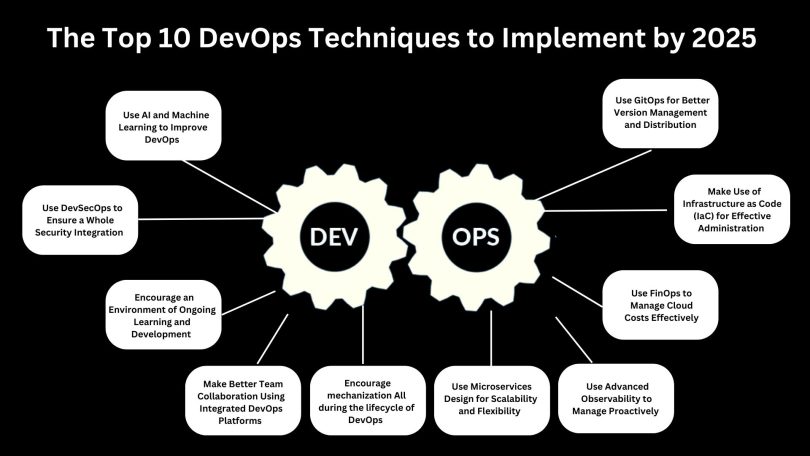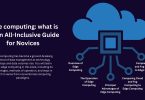The field of software development is still changing quickly as 2024 – 2025 approaches. Organizations need to hone their DevOps techniques in order to maintain their competitiveness and guarantee effective software delivery.
Top 10 DevOps techniques
The top ten DevOps techniques to improve your development and operations in 2025 are listed below.
. Use AI and Machine Learning to Improve DevOps
By 2025, incorporating machine learning and artificial intelligence (AI) into your DevOps procedures will be revolutionary. By analyzing large datasets, these technologies can improve decision-making, automate repetitive operations, and anticipate possible problems. AI and ML may enhance application performance, strengthen security, and optimize code quality, improving the accuracy and efficiency of your DevOps procedures.
- Use GitOps for Better Version Management and Distribution
For managing application code and infrastructure, GitOps is becoming more and more important. Git can be used as the main source of truth to expedite deployment procedures and preserve consistency between environments. GitOps makes automatic deployments easier and offers an auditable, transparent change trail two essential components for managing complex systems and enhancing operational dependability.
- Use DevSecOps to Ensure a Whole Security Integration
DevSecOps, or the direct integration of security into your DevOps pipeline, is going to be crucial in 2025. This procedure guarantees that security controls are incorporated at every stage of the software development process. Your software’s resilience against security attacks can be strengthened and possible hazards can be proactively addressed by automated security checks and vulnerability assessments from the outset.
- Make Use of Infrastructure as Code (IaC) for Effective Administration
One essential method for managing infrastructure through code is still Infrastructure as Code (IaC). Infrastructure can be defined and automated with the help of programs like Terraform, Ansible, and Pulumi, which guarantee consistency and lower human error rates. IaC is particularly helpful in promoting cooperation between the development and operations teams, managing intricate multi-cloud setups, and enabling scalability.
- Encourage an Environment of Ongoing Learning and Development
DevOps success requires fostering a culture that prioritizes ongoing learning and development. This means embracing a growth mentality, doing frequent training, and promoting experimentation in 2025. Iterative feedback and blameless post-mortems are two practices that support continuous innovation and improvement, keeping teams flexible and able to adjust to new technologies.
- Use FinOps to Manage Cloud Costs Effectively
Effective cloud cost management is crucial as multi-cloud options gain popularity. Financial Operations, or FinOps, monitors consumption, optimizes resource allocation, and controls costs by fusing financial accountability with cloud cost management. Organizations can maximize the value of their cloud investments and make well-informed decisions about cloud expenditures by implementing FinOps procedures.
- Make Better Team Collaboration Using Integrated DevOps Platforms
Code collaboration, continuous integration/continuous deployment, and monitoring are managed in integrated environments via DevOps systems like GitHub Actions, Azure DevOps, and GitLab. By 2025, utilizing these platforms will be essential to improving teamwork, optimizing processes, and obtaining insight into development procedures. These tools facilitate better collaboration, lessen friction, and hasten the release of software.
- Use Advanced Observability to Manage Proactively
Proactive system monitoring and incident handling depend on observability. By putting advanced observability principles into effect in 2025, you’ll be able to use logs, metrics, and traces to obtain deeper insights into system performance. Robust monitoring capabilities are provided by tools such as Prometheus, Grafana, and the ELK Stack, which allow for early issue discovery and excellent system reliability.
- Encourage mechanization All during the lifecycle of DevOps
A key component of efficient DevOps procedures is automation. By 2025, it will be imperative to extend automation throughout the whole DevOps lifecycle, from testing and code integration to deployment and monitoring. Software development can become more dependable and efficient by minimizing manual labor, reducing errors, and speeding up delivery through automated CI/CD pipelines, infrastructure provisioning, and security checks.
. Use Microservices Design for Scalability and Flexibility
Using microservices architecture is still essential for creating applications that are both scalable and flexible. Teams may build, deploy, and scale specific components of monolithic apps by breaking them down into smaller, independent services. Adopting microservices in 2025 will improve flexibility, expedite development cycles, and streamline maintenance. Microservices must be managed with the help of tools like Kubernetes and Docker, which offer vital orchestration and containerization features.
In summary
If your company follows these ten best DevOps practices by 2025, it will be well-positioned to succeed in the cutthroat software market. You can expedite your DevOps processes and produce high-quality software more quickly by utilizing AI and ML, putting security first, maximizing cloud costs, and encouraging a continuous improvement mindset. Maintaining current with these procedures will guarantee that your company stays creative and adaptable in the years to come.








